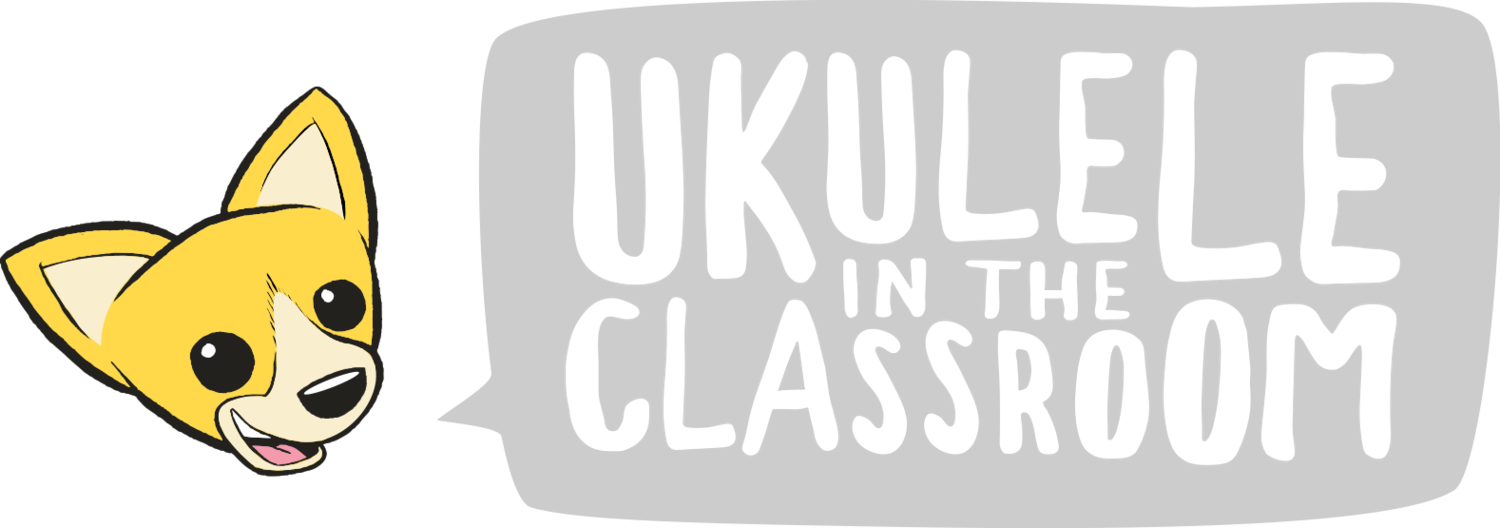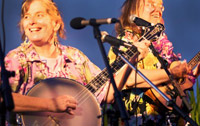Interview: Cathy Fink & Marcy Marxer
By James Hill
Like many of us, Cathy Fink and Marcy Marxer are crazy for the ukulele. Unlike many of us, however, Cathy and Marcy have won two Grammy Awards. What's their secret? Ukulele Yes! editor James Hill catches up with this busy duo.
James Hill: Marcy, is it true that you studied with Roy Smeck? What was that like?
Cathy, Marcy and six of their favourite ukes.
Marcy Marxer: Yes, it's true. Roy was a great practical joker. He would go to extremes for a good gag. He was a little harder on the guys than he was on me. I think I surprised him walking in the door. I'm under the impression that he didn't have many female students.
Roy didn't explain anything, he just played. He didn't name a single chord or note. I had a $10.00 plastic tape recorder from Radio Shack that I used to make cassette tapes of the lessons. Then I'd run off to a quiet corner and write down as much as I could remember and use the tapes to fill in the blanks.
JH: What about you, Cathy, how did you discover the ukulele?
“[Roy Smeck] was a great practical joker. He would go to extremes for a good gag.”
Cathy Fink: In 1973 I lived in Montreal and gave lessons on Appalachian dulcimer to a sweet elderly woman named Annie Elliot. We really enjoyed each other's company and in 1974 when I started touring full time, she was moving to a seniors' community in Toronto. Annie gave me a vintage Gibson soprano ukulele that I have enjoyed ever since. It's in great shape. I rarely pick up a uke without thinking of her. I've rescued quite a few ukes from garage sales and flea markets and folks have even given me a few, realizing that they'd have a great home.
As Marcy and I began recording together in the early 1980s, the uke seemed to fit something on nearly every album, especially the family recordings. It was natural for us to play some uke music together and in the last few years, we've finally made more time to explore lots of ukulele styles.
JH: Cathy, you're a frailing/clawhammer expert. Is there any history of clawhammer ukulele or are you (and others) charting a new course for the instrument?
CF: Jere Canote and Aaron Keim have both done a lot with clawhammer ukulele. The clawhammer style on banjo is so personalized, so when you adapt it to the ukulele, it's rare that two players will use the exact same style. I think clawhammer adds to the breadth of what the uke can do. I don't think it's versatile enough to only play clawhammer ukulele, but it definitely adds to the fun.
“[Clawhammer] is so personalized, so when you adapt it to the ukulele, it’s rare that two players will use the exact same style.”
JH: Is there a natural link between ukulele and banjo? Technique-wise and/or repertoire-wise?
CF: Historically, there's no natural link, but musically, when a tenor, concert or soprano ukulele is tuned with a high G, it's like a little mini-banjo. In fact, I first got the idea to play clawhammer on a banjo-ukulele. I play banjo in many different tunings, so getting used to another is easy. It's like a 4 string banjo where the 4th string, the high G, can serve as the "short" drone string on the banjo. You can use it for drones and for lots of interesting syncopations. I have explored which traditional tunes adapt well to not having a lower string for the melody, and experimented with hybrid clawhammer styles that offer up different rhythm patterns.
JH: Marcy, you're a multi-instrumentalist extraordinaire; how is ukulele unique among stringed instruments? Is it really just a small guitar?
MM: Thank you for the kind words, James. Guitar skills are helpful but the ukulele is a mighty instrument on it's own. The tone quality of the high voicings of the uke have been like a magnet for me from the start when I found my first ukulele in a garbage can on my way to school a kid. I tuned it up and was hooked. I started buying Hawaiian records at garage sales and thrift stores and tried to learn as many songs as I could. I also tried the Hula... but that's best left to others.
JH: You also teach quite a bit (I remember you had one of the first ukulele DVDs on the market!). What is the biggest challenge you face as a teacher? How do you overcome it?
“I found my first ukulele in a garbage can on my way to school a kid. I tuned it up and was hooked.”
MM: Ha! That DVD was originally a VHS. Yikes, it has been around a while! Back then the biggest challenge was getting ukuleles that were inexpensive and playable so people could actually get started making music on them. Glad that's changed!
Cathy and Marcy in full swing!
The challenges have evolved over the years. There are still plenty, though. One great challenge now is the popularity of the remarkable younger players like yourself and Jake Shimabukuro who take the instrument to higher levels. People taking up the ukulele these days often have higher expectations of themselves and the instrument. I used to take a Jazz tune to a workshop and some people weren't sure they wanted to try it. Now they're hungry for more. I'm Jazzed about it. No pun intended.
James, jamming with you and the entire Chalmers Doane family at the International Ukulele Ceildih was a great inspiration! The music was top notch with great heart and enthusiasm. What a kick! I felt like a better player by the end of the night. That's when a jam session is at it's best. It was delightful!
JH: Thanks! That really was a great night. One to remember! Tell me... you both do a lot of children's music; how has the ukulele changed your approach to that style of music-making?
CF: I made my first solo children's CD in 1983. It included a great tin pan alley song "A Flea and A Fly in a Flu" which screamed for ukulele and kazoos, as obvious as that sounds. As Marcy and I continued working on new music for families, we are always listening for the best approach to each song. The ukulele can sound very personal, and we used it that way on a song called, "There's Nobody Else Like Me". It can also lead a band beautifully and it kicked of the Grammy-winning CD, "cELLAbration: A Tribute to Ella Jenkins". Ella is a ukulele player and we wanted to make sure there was plenty of ukulele on the CD. So Ella's song, "You'll Sing A Song and I'll Sing A Song" starts with the uke and builds into a full Dixieland arrangement.
“[The ukulele’s] small size means that teachers can use it in their classrooms and not feel like there’s a barrier of some kind between them and the students.”
We use the ukulele a lot in educational work; the small size means that teachers can use the ukulele in their classrooms and not feel like there's a barrier of some kind between them and the students. It's especially great for early childhood classrooms: pre-K through all ages that have "circle time". Same with children's librarians. It's been a mission for us to get librarians, pre-school teachers and other educators to use the ukulele in the classroom. And of course, there are some nice, almost indestructible ukes that kids can play with and get a sense of a stringed instrument. Lastly, we've introduced the ukulele to music therapists and they are finding it fabulous in their work with children and with seniors.
We've also worked hard at engaging families to play music together, make up songs together, take lessons together, etc. The ukulele is again perfect for this because of the size, accessibility, nylon strings and beautiful sound. Most recently, we published a 32 page illustrated book/CD called, "SING TO YOUR BABY", teaching expecting and new parents a repertoire of easy songs to help them become more comfortable with singing to their babies. More than half of the recording I accompanied on ukulele. Of course, we hope new parents will pick up their own ukuleles!
JH: When you're arranging music for your stage show, when do you reach for the ukulele? Is there a particular type of song that just cries out for ukulele?
MM: I love Old Time Music from the late 1800s and early 1900s. The ukulele was used in the Appalachian Mountains at that time by several bands. Then there is the Pop music of the early 1900s like "Bill Bailey Won't You Please come Home" (1902), "By The Light Of The Silvery Moon" (1909). The 1920s brought us "Baby Face" (1926) and "Ain't Misbehavin'" (1929). Jazz took us through the 1930s and 40s. The 1950s brought us Elvis Presley, Chuck Berry, Harry Belafonte and Doo Wop. The 60s to the present brought endless Pop songs... I guess all music cries out for ukulele!
JH: I saw you perform recently (at the Ukulele Ceilidh in Nova Scotia) where you delivered a great all-uke set. Was it a challenge to arrange your repertoire for two ukes?
CF: A lot of the repertoire we've arranged for two ukuleles we created especially for two ukuleles. That would include songs like Django Reinhardt's "Dark Eyes", the duet of clawhammer and fingerpicking on "Snowdrop" by Kirk McGee, and the jazz classic, "Comes Love". We've also created a lot of arrangements for uke and cello-banjo. It's a large, four string banjo tuned like a cello. The tiny size of the uke and huge low sound of the cello banjo are diametric opposites, and they work beautifully together. On a few other tunes I transferred chords from guitar to baritone or tenor ukulele to get the rhythm sound I really wanted behind some of Marcy's lead playing. We loved the challenge and are continuing to do shows that are all/mostly uke. We're also writing quite a few songs on the ukulele.
JH: Last question. What is your go-to party ukulele song? When someone says, "hey, play us a ukulele tune!" what do you play?
MM: "Singing in The Rain." Most people can sing along right away and it can be played with two chords. Instant party!
Two-time Grammy® Award Winners, Cathy Fink & Marcy Marxer are a formidable powerhouse of sound, with a repertoire of traditional and contemporary folk, old-time country and swing music. Their superb harmonies are backed by instrumental virtuosity on the acoustic & electric guitar, five-string banjo, mandolin, cello banjo, ukulele, percussion and many other instruments. Their work is well described by the name of their company, "Community Music, Inc." Getting communities to play, sing and enjoy music is what it's all about. Visit www.cathymarcy.com and www.ukulelesocialclub.com for more.





This month, Cynthia Kinnunen gives us some intervalactic tactics
Building recognition of intervals aurally (by ear) and on the page (by sight) helps to improve many aspects of our musical learning, including sight reading, sight singing, harmonizing and more! But knowing where to begin teaching intervals can leave us feeling like we’re on another planet.